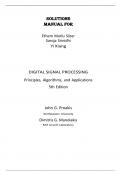SOLUTIONS
MANUAL For
Ethem Mutlu Sözer
Saroja Srinidhi
Yi Xiang
DIGITAL SIGNAL PROCESSING
Principles, Algorithms, and Applications
5th Edition
John G. Proakis
Northeastern University
Dimitris G. Manolakis
MIT Lincoln Laboratory
, Chapter 1
1.1
(a) One dimensional, multichannel, discrete time, and digital.
(b) Multi dimensional, single channel, continuous-time, analog.
(c) One dimensional, single channel, continuous-time, analog.
(d) One dimensional, single channel, continuous-time, analog.
(e) One dimensional, multichannel, discrete-time, digital.
andenvironmentalsustainability.**HistoricalPerspectives**:Overviewofsignificantmilestonesandcontributionsinthedevelopmentofbiologyasascientificdiscipline,includingkeyfigu
res,discoveries,andadvancementsinbiologicaltheories.**ToolsandTechniques**:Introductiontolaboratorytechniques,instruments,andmethodologiesusedinbiologicalresearch,su
chasmicroscopy,DNAsequencing,biochemicalanalysis,andcomputationalbiology.**CurrentChallengesandFrontiers**:Discussiononcontemporarychallengesfacingbiology,suchas
emerginginfectiousdiseases,climatechangeimpacts,biodiversityloss,andtheapplicationofbiotechnologicalinnovations.**SummaryandKeyConcepts**:Thechapterconcludeswitha
summaryofkeyconceptsdiscussed,reinforcingthefoundationalprinciplesofbiologyandpreparingstudentsforfurtherexplorationinsubsequentchapters.Chapter1of"EssentialsofBiolo
gy"aimstoprovidestudentswithacomprehensiveintroductiontothescientificstudyoflife,emphasizingitsbreadth,significance,andrelevanceinunderstandingthenaturalworldandadd
ressingglobalchallenges.Itsetsthestagefordeeperexplorationintobiologicalconceptsandprinciplescoveredthroughoutthetextbook .Ifyouhavespecificquestionsaboutanyofthesetopicsorw
ouldlikemoredetailedinformationonaparticularaspectofChapter1,feelfreetoask!Chapter2Chapter2of"EssentialsofBiology"bySylviaMaderandMichaelWindelspecht,titled"TheChemicalBasisofLife,"typicallydel
vesintothefoundationalprinciplesofchemistryastheyrelatetobiologicalsystems.Here’sanoverviewofwhatyoumightfindinthischapter:**IntroductiontoBiochemistry**:Definitionofbiochemistryasthebranchofch
emistryconcernedwiththechemicalprocessesandsubstancesthatoccurwithinlivingorganisms.**ElementsandAtoms**:Explanationofbasicchemicalelementsessentialtolife,theiratomicstructure(protons,neutro
ns,electrons),andhowatomscombinetoformmolecules.**ChemicalBonds**:Discussionondifferenttypesofchemicalbonds(covalent,ionic,hydrogenbonds)andtheirroleinholdingatomstogetherinmoleculesandc
ompounds.**PropertiesofWater**:Explorationofwaterasapolarmolecule,itsuniqueproperties(highcohesion,adhesion,surfacetension,highspecificheatcapacity),anditsimportanceinbiologicalsystems.**Acids,
Bases,andpH**:Definitionofacidsandbases,theirroleinchemicalreactions,andtheconceptofpHasameasureofhydrogenionconcentration.ImportanceofpHregulationinbiologicalprocesses.**OrganicMolecules**
:Introductiontoorganicmoleculesessentialforlife,includingcarbohydrates,lipids,proteins,andnucleicacids.Structure,function,andbiologicalsignificanceofeachgroupofmolecules.**Carbohydrates**:Structureofc
arbohydrates(monosaccharides,disaccharides,polysaccharides),theirrolesasenergysourcesandstructuralcomponentsincells.**Lipids**:Classificationoflipids(fats,phospholipids,steroids),theirstructure,functio
ns(energystorage,cellmembranes),androlesinbiologicalprocesses.**Proteins**:Structureofproteins(aminoacids,primary,secondary,tertiary,andquaternarystructure),functions(enzymes,structuralproteins,an
tibodies),andproteinsynthesis.**NucleicAcids**:Structureandfunctionofnucleicacids(DNAandRNA),includingnucleotidestructure,DNAreplication,transcription,andtranslation.**EnzymesandCatalysis**:Roleo
fenzymesasbiologicalcatalysts,enzyme-
substrateinteractions,enzymespecificity,factorsinfluencingenzymeactivity,andregulationofenzymefunction.**EnergyandMetabolism**:Overviewofenergytransformationsinbiologicalsystems,includinganintr
oductiontometabolism,energycarriers(ATP),andmetabolicpathways(e.g.,glycolysis,Krebscycle).**SummaryandKeyConcepts**:Thechapterconcludeswithasummaryofkeyconceptsrelatedtothechemicalbasiso
flife,reinforcingunderstandingofthefoundationalprinciplesofbiochemistryandtheirsignificanceinbiologicalprocesses.Chapter2providesacomprehensiveintroductiontothechemicalfoundationsthatunderpinbio
logicalsystems.Itestablishesacrucialunderstandingofhowchemicalprinciplesgovernthestructure,function,andinteractionsofbiologicalmoleculesessentialforlife.Thisknowledgeservesasabasisforfurtherexplorat
ionintocellularprocesses,genetics,andphysiologicalmechanismscoveredinsubsequentchaptersofthetextbook.Ifyouhavespecificquestionsaboutanyofthesetopicsorwouldlikemoredetailedinformationonaparti
cularaspectofChapter2,feelfreetoask!Chapter3Chapter3of"EssentialsofBiology"bySylviaMaderandMichaelWindelspecht,titled"TheOrganicMoleculesofLife,"focusesspecificallyonthemajorclassesoforganicm
oleculesessentialforbiologicalsystems.Here’sanoverviewofwhatyoumightfindinthischapter:**IntroductiontoOrganicMolecules**:Definitionoforganicmoleculesandtheirimportanceasthebuildingblocksoflife.
Overviewofthemajorclassesoforganicmolecules:carbohydrates,lipids,proteins,andnucleicacids
Chapter 2
2.1
(a)
1 2
x(n) = ... 0, , , 1, 1, 1, 1, 0,...
3 3 ↑
. Refer to fig 2.1-1.
(b) After folding s(n) we have
1 1 1 1
2/3
1/3
-3 -2 -1 0 1 2 3 4
, Figure 2.1-1:
2 1
x(− n) = . . . 0, 1, 1, 1, 1, , , 0,... .
↑ 3 3
After delaying the folded signal by 4 samples, we have
2 1
x(− n + 4) = ........ 0, 0, 1, 1, 1, 1, , , 0,.. . .
↑ 3 3
On the other hand, if we delay x(n) by 4 samples we have
12
x(n − 4) = 0
... , 0, , , 1, 1, 1, 1, 0,... .
↑ 3 3
Now, if we fold x(n − 4) we have
2 1
x(− n − 4) = 0
. . . 0, 1, 1, 1, 1, cusesspe , , 0,
cificallyo 3 3
nthemajo
rclassesof
andenvironmentalsustainability.**HistoricalPerspectives**:Overviewofsignificantmil organicm
estonesandcontributionsinthedevelopmentofbiologyasascientificdiscipline,including oleculese
keyfigures,discoveries,andadvancementsinbiologicaltheories.**ToolsandTechniques ssentialfo
**:Introductiontolaboratorytechniques,instruments,andmethodologiesusedinbiologi rbiologica
calresearch,suchasmicroscopy,DNAsequencing,biochemicalanalysis,andcomputation lsystems.
albiology.**CurrentChallengesandFrontiers**:Discussiononcontemporarychallengesf Here’san
acingbiology,suchasemerginginfectiousdiseases,climatechangeimpacts,biodiversityl overview
oss,andtheapplicationofbiotechnologicalinnovations.**SummaryandKeyConcepts**: ofwhatyo
Thechapterconcludeswithasummaryofkeyconceptsdiscussed,reinforcingthefoundati umightfin
onalprinciplesofbiologyandpreparingstudentsforfurtherexplorationinsubsequentcha dinthisch
pters.Chapter1of"EssentialsofBiology"aimstoprovidestudentswithacomprehensiveint apter:**I
roductiontothescientificstudyoflife,emphasizingitsbreadth,significance,andrelevanc ntroducti
einunderstandingthenaturalworldandaddressingglobalchallenges.Itsetsthestageford ontoOrga
eeperexplorationintobiologicalconceptsandprinciplescoveredthroughoutthetextboo nicMolec
k.Ifyouhavespecificquestionsaboutanyofthesetopicsorwouldlikemoredetailedinformationonapartic ules**:De
ularaspectofChapter1,feelfreetoask!Chapter2Chapter2of"EssentialsofBiology"bySylviaMaderandM finitionof
ichaelWindelspecht,titled"TheChemicalBasisofLife,"typicallydelvesintothefoundationalprinciplesof organicm
chemistryastheyrelatetobiologicalsystems.Here’sanoverviewofwhatyoumightfindinthischapter:**I oleculesa
ntroductiontoBiochemistry**:Definitionofbiochemistryasthebranchofchemistryconcernedwiththec ndtheiri
hemicalprocessesandsubstancesthatoccurwithinlivingorganisms.**ElementsandAtoms**:Explanati mportanc
onofbasicchemicalelementsessentialtolife,theiratomicstructure(protons,neutrons,electrons),andh easthebui
owatomscombinetoformmolecules.**ChemicalBonds**:Discussionondifferenttypesofchemicalbon ldingbloc
ds(covalent,ionic,hydrogenbonds)andtheirroleinholdingatomstogetherinmoleculesandcompounds ksoflife.O
.**PropertiesofWater**:Explorationofwaterasapolarmolecule,itsuniqueproperties(highcohesion,a verviewo
dhesion,surfacetension,highspecificheatcapacity),anditsimportanceinbiologicalsystems.**Acids,Ba fthemajo
ses,andpH**:Definitionofacidsandbases,theirroleinchemicalreactions,andtheconceptofpHasameas rclassesof
ureofhydrogenionconcentration.ImportanceofpHregulationinbiologicalprocesses.**OrganicMolecu organicm
les**:Introductiontoorganicmoleculesessentialforlife,includingcarbohydrates,lipids,proteins,andnu olecules:
cleicacids.Structure,function,andbiologicalsignificanceofeachgroupofmolecules.**Carbohydrates** carbohyd
:Structureofcarbohydrates(monosaccharides,disaccharides,polysaccharides),theirrolesasenergysou rates,lipi
rcesandstructuralcomponentsincells.**Lipids**:Classificationoflipids(fats,phospholipids,steroids),t ds,protei
heirstructure,functions(energystorage,cellmembranes),androlesinbiologicalprocesses.**Proteins* ns,andnu
*:Structureofproteins(aminoacids,primary,secondary,tertiary,andquaternarystructure),functions(e cleicacids
nzymes,structuralproteins,antibodies),andproteinsynthesis.**NucleicAcids**:Structureandfunctio
nofnucleicacids(DNAandRNA),includingnucleotidestructure,DNAreplication,transcription,andtransl
ation.**EnzymesandCatalysis**:Roleofenzymesasbiologicalcatalysts,enzyme-
substrateinteractions,enzymespecificity,factorsinfluencingenzymeactivity,andregulationofenzyme
function.**EnergyandMetabolism**:Overviewofenergytransformationsinbiologicalsystems,includi
nganintroductiontometabolism,energycarriers(ATP),andmetabolicpathways(e.g.,glycolysis,Krebscy
cle).**SummaryandKeyConcepts**:Thechapterconcludeswithasummaryofkeyconceptsrelatedtoth
echemicalbasisoflife,reinforcingunderstandingofthefoundationalprinciplesofbiochemistryandtheirs
ignificanceinbiologicalprocesses.Chapter2providesacomprehensiveintroductiontothechemicalfoun
dationsthatunderpinbiologicalsystems.Itestablishesacrucialunderstandingofhowchemicalprinciples
governthestructure,function,andinteractionsofbiologicalmoleculesessentialforlife.Thisknowledges
ervesasabasisforfurtherexplorationintocellularprocesses,genetics,andphysiologicalmechanismscov
eredinsubsequentchaptersofthetextbook.Ifyouhavespecificquestionsaboutanyofthesetopicsorwou
ldlikemoredetailedinformationonaparticularaspectofChapter2,feelfreetoask!Chapter3Chapter3of"
EssentialsofBiology"bySylviaMaderandMichaelWindelspecht,titled"TheOrganicMoleculesofLife,"fo
, ,...
↑





